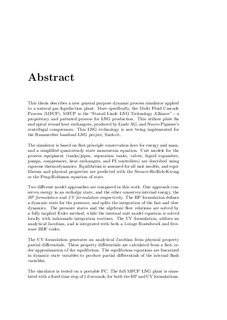| dc.description.abstract | This thesis describes a new general purpose dynamic process simulator applied to a natural gas liquefaction plant. More specifically, the Multi Fluid Cascade Process (MFCP). MFCP is the “Statoil Linde LNG Technology Alliance” - a proprietary and patented process for LNG production. This utilizes plate fin and spiral wound heat exchangers, produced by Linde AG, and Nuovo Pignone’s centrifugal compressors. This LNG technology is now being implemented for the Hammerfest baseload LNG project, Snøhvit.
The simulator is based on first principle conservation laws for energy and mass, and a simplified quasi-steady state momentum equation. Unit models for the process equipment (tanks/pipes, separation tanks, valves, liquid expanders, pumps, compressors, heat exchangers, and PI controllers) are described using rigorous thermodynamics. Equilibrium is assumed for all unit models, and equilibrium and physical properties are predicted with the Swoave-Redlich-Kwong or the Peng-Robinson equation of state.
Two different model approaches are compared in this work. One approach conserves energy in an enthalpy state, and the other conserves internal energy, the HP formulation and UV formulation respectively. The HP formulation defines a dynamic state for the pressure, and splits the integration of the fast and slow dynamics. The pressure states and the algebraic flow relations are solved by a fully implicit Euler method, while the internal unit model equation is solved locally with tailormade integration routines. The UV formulation, utilizes an analytical Jacobian, and is integrated with both a 1-stage Rosenbrock and freeware BDF codes.
The UV formulation generates an analytical Jacobian from physical property partial differentials. These property differentials are calculated from a first order approximation of the equilibrium. The equilibrium equations are linearized in dynamic state variables to produce partial differentials of the internal flash variables.
The simulator is tested on a portable PC. The full MFCP LNG plant is simulated with a fixed time step of 1.0 seconds, for both the HP and UV formulations.
The HP formulation has 611 ODE states. The UV formulation uses the 1-stage Rosenbrock method integrating a system with 1025 ODE states. The case simulated is a set point step for the LNG temperature controller. The plant is simulated over 9000 seconds. The major process dynamics are sampled every second, and plotted. The average performance of both formulation is better that 7 times real time. The worst local performance of the UV formulation is 1.7 times faster than the HP formulation, but more than 6 times faster than real time. The HP and UV formulations gave significantly different dynamic predictions.
The BDF codes proved too slow for practical use on the MFCP configuration.
The dynamic simulators in industry today are typically using a HP formulation, with precalculated thermodynamic data stored in look-up tables. The simulations of the full LNG plant show that simulators, utilizing EOS equilibrium descriptions, soon will be able to compare with modern industry simulators. | nb_NO |
